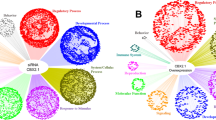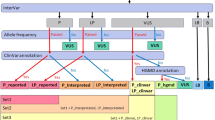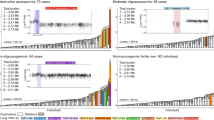Abstract
46,XY disorders of sex development (DSD) refer to a wide range of abnormal genitalia, including hypospadias, which affects ∼0.5% of male newborns. We identified three different nonsense mutations of CXorf6 in individuals with hypospadias and found that its mouse homolog was specifically expressed in fetal Sertoli and Leydig cells around the critical period for sex development. These data imply that CXorf6 is a causative gene for hypospadias.
This is a preview of subscription content, access via your institution
Access options
Subscribe to this journal
Receive 12 print issues and online access
$209.00 per year
only $17.42 per issue
Buy this article
- Purchase on Springer Link
- Instant access to full article PDF
Prices may be subject to local taxes which are calculated during checkout


Similar content being viewed by others
Accession codes
Change history
07 December 2006
Agneta Nordenskjöld is in the Department of Molecular Medicine and Surgery, Karolinska University Hospital, Stockholm, Sweden. This error has been corrected in the HTML and PDF versions of the article.
References
Laporte, J. et al. Hum. Mol. Genet. 6, 1505–1511 (1997).
Biancalana, V. et al. Hum. Genet. 112, 135–142 (2003).
Hu, L.J. et al. Hum. Mol. Genet. 5, 139–143 (1996).
Bartsch, O., Kress, W., Wagner, A. & Seemanova, E. Cytogenet. Cell Genet. 85, 310–314 (1999).
Laporte, J. et al. Genomics 41, 458–462 (1997).
Winter, J.S.D. et al. J. Clin. Endocrinol. Metab. 42, 679–686 (1976).
Hentze, M.W. & Kulozik, A.E. Cell 96, 307–310 (1999).
Tsai, T.C. et al. Neuromuscul. Disord. 15, 245–252 (2005).
Grumbach, M.M., Hughes, I.A. & Conte, F.A. Disorders of Sex Differentiation: Williams Textbook of Endocrinology 10th edn. 842–1002 (Saunders, Philadelphia, 2002).
Nomura, M. et al. J. Biochem. 124, 217–224 (1998).
Acknowledgements
We thank M. Kaji, T. Nagai, I. Sasagawa, K. Ueoka, K. Aoki, W. Kress, O. Bartsch, V. Biancalana, L. Van Maldergem and A. Nordenskjöld for providing us with blood samples from patients; T. Chen, Q. Li, and Y. Shen for participating in the mutation screening; K. Homma for urine steroid profile analysis and F. Kato for technical assistance. This work was supported by a grant for Child Health and Development from the Ministry of Health, Labor and Welfare of Japan (17C-2); by a Grant-in-Aid for Scientific Research on Priority Areas from the Ministry of Education, Science, Sports and Culture of Japan (16086215 and 16590218) and by the Institut National de la Santé et de la Recherche Médicale, the Centre National de la Recherche Scientifique and the College de France.
Author information
Authors and Affiliations
Contributions
Mutation analysis was performed by M.F., Y.W., G.C., C.K. and A.B.-B.; human cDNA screening and RT-PCR by M.F.; mouse expression analysis by K.M., G.Y. and K.M. and phenotype assessment by I.N., T.H., J.L. and T.O. The study was designed and coordinated by J.L. and T.O., and the paper was written by T.O.
Corresponding author
Ethics declarations
Competing interests
The authors declare no competing financial interests.
Supplementary information
Supplementary Fig. 1
PCR-based screening for CXorf6 using human cDNA. (PDF 491 kb)
Supplementary Table 1
Patients examined in the present study with 46,XY disorders of sex development. (PDF 35 kb)
Supplementary Table 2
Primers used in this study. (PDF 21 kb)
Supplementary Table 3
Summary of the four Japanese individuals with a nonsense mutation in CXorf6. (PDF 64 kb)
Rights and permissions
About this article
Cite this article
Fukami, M., Wada, Y., Miyabayashi, K. et al. CXorf6 is a causative gene for hypospadias. Nat Genet 38, 1369–1371 (2006). https://doi.org/10.1038/ng1900
Received:
Accepted:
Published:
Issue Date:
DOI: https://doi.org/10.1038/ng1900
This article is cited by
-
Irisin deletion induces a decrease in growth and fertility in mice
Reproductive Biology and Endocrinology (2021)
-
Clinical and molecular spectrum of 46,XY disorders of sex development that harbour MAMLD1 variations: case series and review of literature
Orphanet Journal of Rare Diseases (2020)
-
Expression of Xenobiotic Biomarkers CYP1 Family in Preputial Tissue of Patients with Hypospadias and Phimosis and Its Association with DNA Methylation Level of SRD5A2 Minimal Promoter
Archives of Environmental Contamination and Toxicology (2018)
-
Next-generation sequencing reveals genetic landscape in 46, XY disorders of sexual development patients with variable phenotypes
Human Genetics (2018)
-
Affected female carriers of MTM1 mutations display a wide spectrum of clinical and pathological involvement: delineating diagnostic clues
Acta Neuropathologica (2017)



